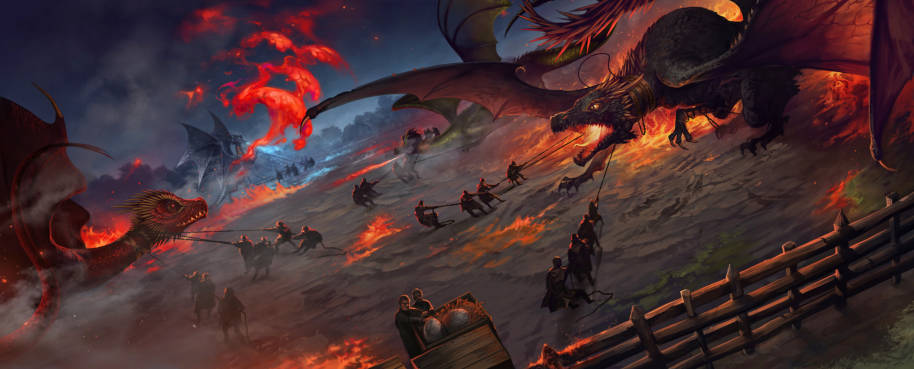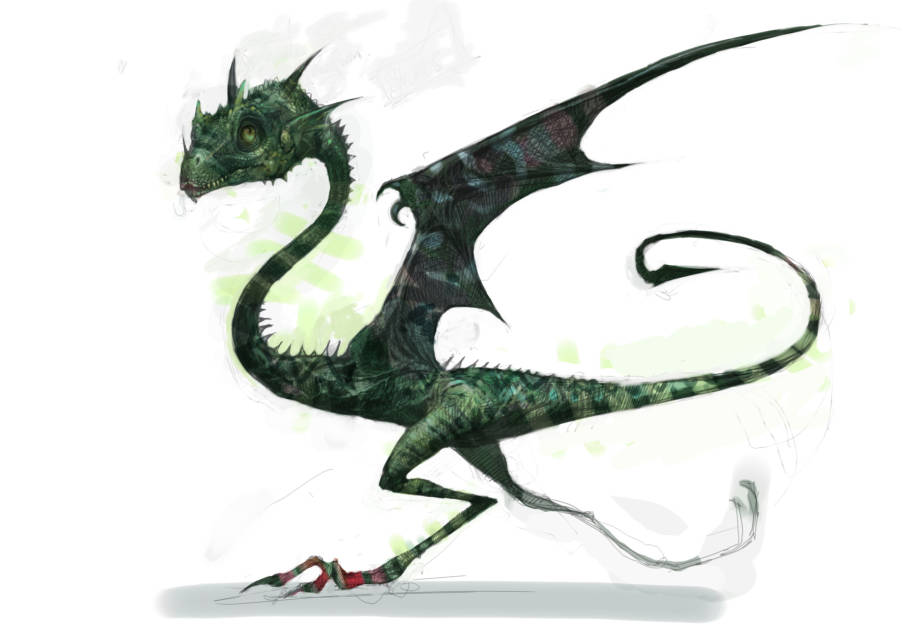
10. Antipodean Opaleye
While this New Zealand native sounds like a stunning creature to behold, it’s lethal lizards we’re looking for on this list, not the prettiest. The pearly-scaled Opaleye rarely kills unless it’s hungry and, even then, mostly sticks to sheep (or on rare occasions, kangaroos). Still, there’s no shame in sitting at the bottom of our dangerous dragons list – it’s still a dragon, after all.
9. Common Welsh Green
Another comparatively non-aggressive species that mainly eats sheep (instant dragon-fail), this one ranks a little higher than the Opaleye thanks to the ‘Ilfracombe Incident’ of 1932. This occurred when a rogue Welsh Green swooped down on a beach full of Muggle holiday-makers. However, thanks to the swift intervention of a wizarding family, the only fatality was an inflatable lilo.

A Welsh Green was also present at the 1994-95 Triwizard Tournament and set fire to Fleur Delacour’s skirt during the first task. Never mess with that girl’s threads!
8. Hebridean Black
So far, British dragons are doing about as well as the UK does in Eurovision. This Scottish dragon certainly looks intimidating, with its sharp ridges, spiked tail and bat-like wings. However, with an appetite for freshly sourced venison, it probably poses more of a threat to baby Bambis than it does the average wizard.
Fun fact: the now-disbanded Banchory Bangers Quidditch team once rounded off a post-match party by attempting to capture a Hebridean Black for a team mascot. The Ministry of Magic was less than impressed when it apprehended the team in Inverness.

7. Romanian Longhorn
Thanks to the Longhorn, Romania is now home to the world’s most important dragon reservation. As the name suggests, Longhorns are easily identified by their great golden horns, which are used to gore their prey. Ouch!
However, this same appendage has made these dragons the targets of poachers, as the powdered horn happens to be a valuable potion ingredient. Numbers fell so low that the Longhorn has been the subject of an intensive breeding programme. Because the world needs more dragon-love.
6. Swedish Short-Snout
As immortalised on the silver trophy for the annual broom race of Sweden, the Short-Snout is an impressive creature indeed. It may not have many human killings to its name, but this is most likely due to the convenient geographical distance between man and beast. The one Cedric Diggory faced didn’t hesitate in attacking his Transfigured dog, or in having a go at Cedric himself, who was left with a huge burn on one side of his face. Diggory got off lucky, considering that the Short-Snout’s blue-hot flame can reduce bones to ash in a matter of seconds. Toasty!
5. Chinese Fireball
Also known as the Liondragon, this breed is notably aggressive towards anything, apart from its own kind. It shoots mushroom-shaped fireballs from its nostrils whenever it’s angered (say for instance, when Viktor Krum hits it with a Conjunctivitis Curse). The scarlet and golden Fireball enjoys snacking on pigs (we imagine it’s a fan of crispy bacon) and is also the first proper man-eater on the list. They only get deadlier from here on.

4. Peruvian Vipertooth
They may be small (well, for dragons at least), but the Vipertooth is one seriously nasty customer. Not only does it have a ‘particularly venomous’ bite, this copper-coloured carnivore loves nothing more than chowing down on human flesh. In fact, the Vipertooth’s hunger for Homo sapiens became such a problem in the 19th century that the International Confederation of Wizards was forced to call in the exterminators.
3. Ukrainian Ironbelly
From the smallest dragon species, we move on to the biggest. This colossal beast weighs in at around six tonnes and, while it’s naturally a little slower than its lighter cousins, it can still take to the skies. One even managed to take off while carrying an entire sailing boat – fortunately, the vessel was empty at the time. You’ll want to be careful of where it lands too, as the Ironbelly can crush dwellings to smithereens. And just in case it wasn’t dangerous enough already, this dragon also boasts razor-sharp talons. Do not approach, unless you happen to be carrying a pair of giant mittens.
2. Norwegian Ridgeback
No one is safe around this monstrous specimen – not humans, nor any other land or sea mammals (including unconfirmed reports about a whale calf), not even fellow Ridgebacks, which is probably why this species is so rare. Its bite seems to be toxic too, if Ron’s green and swollen hand was anything to go by, plus it develops fire-breathing abilities very early on, as Hagrid would testify.

Ah, Norbert! Remember sweet little Norbert? Well, maybe not ‘sweet’. Or ‘little’ for that matter, at least not for very long. Oops, and that should have been ‘Norberta’. Apologies, please don’t burn us!
1. Hungarian Horntail
It was a close call between this one and the Ridgeback. But when Mr Scamander himself supposes the Horntail to be the most dangerous dragon out there, who are we to argue? After all, when we saw that angry mother Horntail in action at the Triwizard Tournament, none of us wanted to be in Harry’s shoes.
This deadly dragon has it all. Horns, check. Spikes, check. Longest fire-breathing range of all known dragon types? Check – for the record, you could find yourself flambéed from up to 50 feet away. You wouldn’t get far sneaking up on one either, not with the massive tail spikes it happens to be rocking. According to Charlie Weasley, ‘Its back end’s as dangerous as its front.’ And that’s really saying something.


